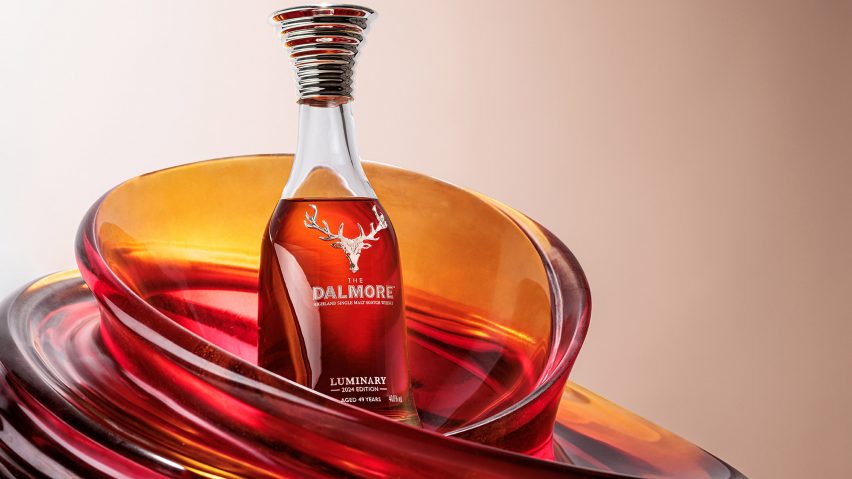UK studio Zaha Hadid Architects has created a one-off glass sculpture for whisky distillery The Dalmore to present a bottle of the brand's single malt whisky.
Named The Dalmore Luminary No.2 Rare Sculpture, the piece was created as the second in a series designed to raise money for the V&A Dundee museum.
The first piece – a 48-piece timber sculpture informed by kintsugi – was designed by the museum's architect Kengo Kuma in 2022.
For Zaha Hadid Architects' piece, director Melodie Leung was informed by the shapes of the whisky stills used to distil the drink and the motion of the liquid when swirled in a glass.
"The idea for the swirling shape originated when I was first learning about the stills and the unique copper shapes that the Dalmore makes the whisky in," Leung told Dezeen.
"But also, it draws on the repertoire that we're working on in the office, which is this idea of changing speed and velocity," she continued.
"And there's a three-dimensional vortex to the way that it moves around. From a formal level, it was really important to me to get the proportions right. I could literally tell a story about the shape of the sculpture for hours."
According to Leung, the complexity of the finished piece reflects the process through which it was created.
"What was really important about this project is we just kept revisiting it, and every time we revisited, we brought in another layer," she explained.
"So literally, when you look at the sculpture, you see that there are a few layers that swirl around each other, and then there's a secondary layer, which are the ripples. And then there's a third one, which is the finer layer of the ripples."
Leung aimed to create a shape from glass that was "right on that edge of what's possible".
"It's a challenge, the shape is always changing," she said. "There was such a thin layer of glass moving behind the decanter and such a thick volume of glass at the base on the left side, but then it also sweeps up and cantilevers on the right side. "
"It was just about finding the tension of them bringing out of the glass as much as they could of our original design, but also leaving it to what the glass can do," she continued. "So there's that tension of working with the limitations of the glass and working with the hands of the artists."
The piece was made of amber cast glass by The Glass Foundry and took 12 weeks to create in a kiln and over 500 hours to polish. The complex form of the sculpture meant that all the other glass producers Leung approached to make the piece turned it down.
"Zaha Hadid Architects looked everywhere to try and find somebody to make this piece for them when they decided it was going to be glass," said The Glass Foundry creative director Fiaz Elson.
"They couldn't find anyone, nobody wanted to take it on – mainly because it's going to be in the kiln for about four months," she continued. "It's such a challenge to try and work on a piece that you don't know if it's going to work or not."
The finished sculpture was revealed at an event at the V&A Dundee last month, along with two limited-edition whiskies that The Dalmore's master distiller Richard Paterson and master whisky maker Gregg Glass worked with Leung to create – a 16-year-old variety and a 49-year old Highland single malt.
A bottle of the latter, which includes notes of roast chestnuts informed by Leung's childhood memories of the aromas from street food carts in Hong Kong, will be auctioned together with the sculpture at Sotheby's in May. Expected to achieve upwards of six figures, all proceeds from the auction will go to the V&A Dundee.

